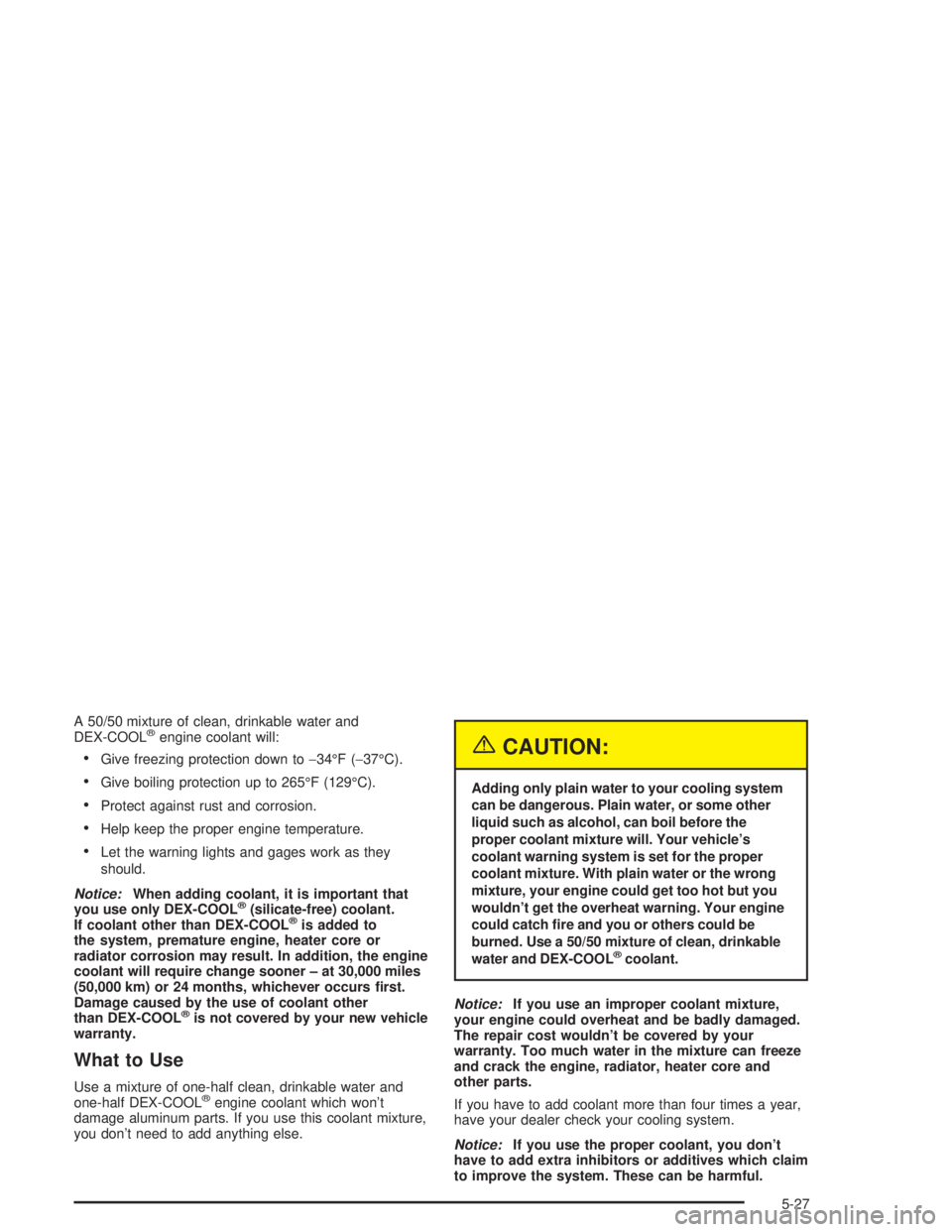Page 278 of 432

Making Turns
Notice:Making very sharp turns while trailering
could cause the trailer to come in contact with
the vehicle. Your vehicle could be damaged.
Avoid making very sharp turns while trailering.
When you're turning with a trailer, make wider turns than
normal. Do this so your trailer won't strike soft shoulders,
curbs, road signs, trees or other objects. Avoid jerky or
sudden maneuvers. Signal well in advance.
Turn Signals When Towing a Trailer
When you tow a trailer, your vehicle may need a
different turn signal ¯asher and/or extra wiring.
Check with your dealer. The arrows on your instrument
panel will ¯ash whenever you signal a turn or lane
change. Properly hooked up, the trailer lamps will also
¯ash, telling other drivers you're about to turn,
change lanes or stop.
When towing a trailer, the arrows on your instrument
panel will ¯ash for turns even if the bulbs on the trailer
are burned out. Thus, you may think drivers behind
you are seeing your signal when they are not. It's
important to check occasionally to be sure the trailer
bulbs are still working.Your vehicle has bulb warning lights. When you plug
a trailer lighting system into your vehicle's lighting
system, its bulb warning lights may not let you know if
one of your lamps goes out. So, when you have a trailer
lighting system plugged in, be sure to check your
vehicle and trailer lamps from time to time to be sure
they're all working. Once you disconnect the trailer
lamps, the bulb warning lights again can tell you if one
of your vehicle lamps is out.
Driving On Grades
Reduce speed and shift to a lower gear before you start
down a long or steep downgrade. If you don't shift
down, you might have to use your brakes so much that
they would get hot and no longer work well.
On a long uphill grade, shift down and reduce your
speed to around 45 mph (70 km/h) to reduce the
possibility of engine and transaxle overheating.
If you have overdrive, you may have to drive in
THIRD (3) instead of AUTOMATIC OVERDRIVE (D).
4-42
Page 307 of 432

A 50/50 mixture of clean, drinkable water and
DEX-COOLžengine coolant will:
·Give freezing protection down to-34ÉF (-37ÉC).
·Give boiling protection up to 265ÉF (129ÉC).
·Protect against rust and corrosion.
·Help keep the proper engine temperature.
·Let the warning lights and gages work as they
should.
Notice:When adding coolant, it is important that
you use only DEX-COOLž(silicate-free) coolant.
If coolant other than DEX-COOLžis added to
the system, premature engine, heater core or
radiator corrosion may result. In addition, the engine
coolant will require change sooner ± at 30,000 miles
(50,000 km) or 24 months, whichever occurs ®rst.
Damage caused by the use of coolant other
than DEX-COOL
žis not covered by your new vehicle
warranty.
What to Use
Use a mixture of one-half clean, drinkable water and
one-half DEX-COOLžengine coolant which won't
damage aluminum parts. If you use this coolant mixture,
you don't need to add anything else.
{CAUTION:
Adding only plain water to your cooling system
can be dangerous. Plain water, or some other
liquid such as alcohol, can boil before the
proper coolant mixture will. Your vehicle's
coolant warning system is set for the proper
coolant mixture. With plain water or the wrong
mixture, your engine could get too hot but you
wouldn't get the overheat warning. Your engine
could catch ®re and you or others could be
burned. Use a 50/50 mixture of clean, drinkable
water and DEX-COOL
žcoolant.
Notice:If you use an improper coolant mixture,
your engine could overheat and be badly damaged.
The repair cost wouldn't be covered by your
warranty. Too much water in the mixture can freeze
and crack the engine, radiator, heater core and
other parts.
If you have to add coolant more than four times a year,
have your dealer check your cooling system.
Notice:If you use the proper coolant, you don't
have to add extra inhibitors or additives which claim
to improve the system. These can be harmful.
5-27
Page 431 of 432

United States ± Customer Assistance.................. 7-4
Uplevel DIC with Trip Computer........................3-53
Up-Shift Light.................................................3-35
Used Replacement Wheels..............................5-76
Using Cleaner on Fabric..................................5-91
Using Song List Mode...................................3-126
V
Variable Effort Steering....................................4-14
Vehicle
Control........................................................ 4-6
Damage Warnings........................................... iv
Loading......................................................4-35
Symbols......................................................... iv
Vehicle Identi®cation
Number (VIN).............................................5-98
Service Parts Identi®cation Label...................5-98
Vehicle Storage..............................................5-48
Ventilation Adjustment......................................3-29
Visor Vanity Mirror..........................................2-13
Visors...........................................................2-13
W
Warning Lights, Gages and Indicators................3-31
Warnings.......................................................3-65
DIC Warnings and Messages........................3-65
Hazard Warning Flashers............................... 3-4Warnings (cont.)
Other Warning Devices.................................. 3-5
Safety and Symbols......................................... iii
Vehicle Damage.............................................. iv
Washing Your Vehicle......................................5-93
Weatherstrip Lubrication...................................6-11
Weight of the Trailer........................................4-38
Weight of the Trailer Tongue.............................4-39
What Kind of Engine Oil to Use........................5-18
What Kind of Oil to Use..................................5-21
What to Do with Used Oil................................5-21
What to Use..........................................5-27, 5-43
Wheels
Alignment and Tire Balance..........................5-75
Replacement...............................................5-75
When to Add..................................................5-43
When to Add Engine Oil..................................5-17
When to Change Engine Oil
(GM Oil Life System)...................................5-20
When to Check......................................5-21, 5-69
When to Check and Change............................5-24
When to Check Power Steering Fluid................5-42
When You Are Ready to Leave After
Parking on a Hill.........................................4-43
Where to Put the Restraint...............................1-38
Why Safety Belts Work....................................1-11
Window Lock-Out............................................2-13
Windows.......................................................2-12
Power........................................................2-13
15
Page:
< prev 1-8 9-16 17-24